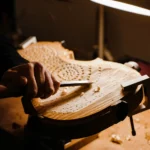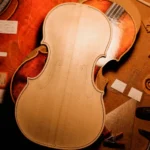The Things You Should Know About Violin Sound
Back to BlogThis beautiful and elegant musical instrument weaves its way into the hearts and souls of people all over the world. With such beloved tones and remarkable sound, the violin is celebrated throughout the musical world. It is being played in so many genres.
But what do you know about the violin sound? Let’s see now.
Have you ever thought about how its sound is produced and made? Your ability to create beautiful sounds depends on things like the strings, the bow, and the composition of the wood, all working together in perfect synergy. There is a lot of physics in the violin that builds its sounds. Just starting with the sound itself, any sound produced and heard by us travels through the air by vibration waves.
The secret behind the violin sound
To produce the violin sound, energy from the vibrating string is transferred to the instrument’s main body—called the soundbox. It is the vibrations of these plates that produce most of the sound.
The violin’s front plate is carved from a single piece of fine-grained pine. The backplate and sides are made of maple. Two elegantly F-holes are cut into the front plate. In the early 16th century, stringed instrument makers discovered that the pitch of an instrument could be increased by inserting a solid rod – or “soundpost” – between the back and front plates, close to the feet of the bridge.
This was responsible for increasing the radiating volume of the instrument, making it stronger. When the bowed strings exert force, the vibration goes to the bridge, and the other side of the plate vibrates with a larger amplitude.
Over the years, luthiers have been making improvements, and with studies, new experiments have been added to the violin.
Some parts and accessories of the violin are crucial for producing the special violin sound and have a big role
Bridge
The bridge is one of these pieces of a violin, it is responsible for converting the transverse forces of the strings into vibrational modes of the soundbox, and also defines the effective vibrating length of the string. When perfectly positioned, it transfers the vibrating energy to the body of the violin and the air it contains.
F-holes
Playing on the acoustic role, we have the soundholes or f-holes. They increase their vibrational modes at high frequencies. More importantly, they increase low-frequency sound output. The frequency of the instrument’s sound is determined by the size of the f-holes and the volume of the instrument. This frequency is the only acoustic resonance over which violin makers have almost complete control.
Soundpost and Bass bar
Located right under the feet of the bridge. The vertical, moveable piece connecting the plate’s top and bottom is called the soundpost. It is responsible for keeping the belly (top plate) of your violin from collapsing, providing a pivot point for the strings, and channeling the energy of the bridge to your instrument’s backplate.
The Bass bar can also be called the heart of the instrument. Right beneath the violin’s top plate guides most of the bridge’s energy into lower-order modes, allowing it to be dispersed over a large area of the belly. Because of advances in woodworking, the bass bar and sound post were made bigger during the 19th century, strengthening the instrument.
Luthier’s secret: The person behind the handcrafting is the one who makes the violin sound, after all.
Behind every masterpiece, there’s the artist, the maker who skillfully builds the instrument, and the brain that works with physics to create these beautiful sounds. The creation of the tones starts with choosing the best wood possible for the front and back plates and tapping it to measure how well it rings. And then comes the carving and arching.
By listening to and feeling the sound of the plates, the maker can learn to adjust their thicknesses to produce a fine-sounding instrument. Through the years, theories have come up relating to the account of the Stradivarius (one of the greatest luthiers of all time) secret. The most popular has been that the varnish had some sort of “magic” composition.
The main purpose of the varnish is to protect the instrument from dirt and moisture and to stop it from absorbing moisture from the player’s hands. And although many luthiers create their own recipe for varnish, no concrete evidence supports the secret formula theory.
Moreover, all the steps in violin-making are crucial, and they develop a unique violin sound.
The differences in a violin’s sound result from a combination of many factors, such as strings, plate thickness, bow, pressure, etc. In the end, each sound created turns out to be very unique, but in the violin world, we try to classify them, although it is very personal to each musician.
Violins can be full, lively, singing, eloquent, introspective, supernatural, sensuous, lustrous, bright, metallic, vibrant, clear, dark, rough… Usually, to make a good choice, the violin player must know well about different kinds of tones (from other instruments) and compare them. Choosing a new instrument is not an easy task, but it’s worth the effort. It’s a valuable instrument that we are talking about!
Here at Amorim Fine Violins, we developed a comparison tool on our website. You can give it a try now and see what kind of violin sound most pleases your ears! It’s free, and we guarantee it will clear your mind and make a choice easier!









